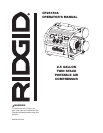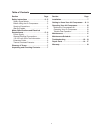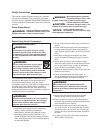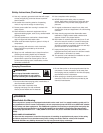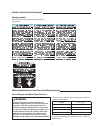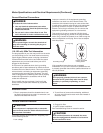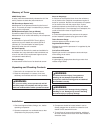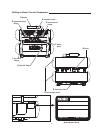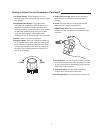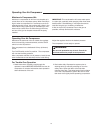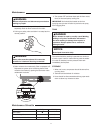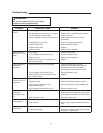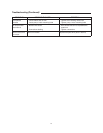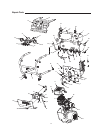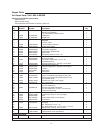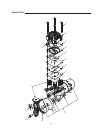
7
ASME Safety Valve
A safety valve that automatically releases the air if the
tanks’ pressure exceeds the preset maximum.
PSI (Pounds per Square Inch)
Measurement of the pressure exerted by the force of
the air. The actual psi output is measured by a pressure
gauge on the compressor
SCFM (Standard Cubic Feet per Minute)
Sometimes called CFM (Cubic Feet per Minute).
Measurement of air volume delivered by the compressor.
Air Delivery
A combination of psi and SCFM. The air delivery
required by a tool is stated as (number) SCFM at
(number) psi. The combination of these figures
determines what size unit is needed.
Air Tank Capacity
The volume of air stored in the tanks and available for
immediate use. Large tanks allow the intermittent use
of an air tool with an air requirement higher than the
compressor’s rated delivery.
Volts or Voltage
A measurement of the force of an electrical current.
Amps or Amperage
A measure of the electrical force minus the resistance
on an electrical line. Ridgid air compressors require 15
amps for operation. Be sure the compressor will operate
on an electrical line with the proper amps. If other
appliances operate on the same line, they will reduce
the available amps. If the amperage is not adequate, the
result will be blown fuses or tripped circuits.
Regulator
A control that adjusts the line pressure to the proper
amount needed to operate spray guns and air tools.
Tanks Pressure Gauge
Indicates pressure of the air tanks in psi.
Regulated Outlet Gauge
Displays the current line pressures. It is regulated by the
regulator knob.
Cut-in/Cut-off Pressure
Specific psi at which a compressor starts and stops
while refilling the air tanks.
Universal Motor
A lightweight AC single phase brush-type motor that
rotates at high RPMs.
Glossary of Terms
1. Remove the air compressor from the carton.
2. Place the compressor on a secure, level, and
stationary work surface and look it over carefully.
Unpacking and Checking Contents
!
WARNING:
For your own safety, never operate unit until all
assembly steps are complete and until you have
read and understood the entire operator’s manual.
!
WARNING:
To reduce the risk of injury, if any parts are
missing, do not attempt to operate the air
compressor until the missing parts are obtained
and installed correctly.
!
WARNING:
Do not operate unit if damaged during shipping,
handling or use. Damage may result in bursting
and cause injury or property damage.
1. Check and tighten all bolts, fittings, etc., before
operating compressor.
2. Operate compressor in a ventilated area so that
compressor may be properly cooled.
3. Compressor should be located where it can be
directly plugged into an outlet. An extension cord
should not be used with this unit.
4. To avoid loss of power and overheating, additional
air hose must be used to reach work area instead of
extension cords.
Installation



